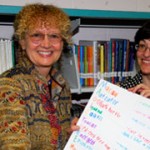Mary Pope Osborne’s life has been filled with travel and adventure. Before her 15th birthday, her family moved at least seven times while her father was on active duty in the military. As a young adult, Osborne lived in a cave on Crete and visited 16 Asian countries, nearly losing her life in an earthquake in Afghanistan, in a riot in Kabul, and to blood poisoning in Katmandu. Now, Osborne travels in her imagination visiting different cultures through her books. She and her readers have explored Greek and Norse mythology, and American tall tales; time-traveled back to the age of dinosaurs, mummies, and ninjas; visited rain forests, the Arctic, and Ancient Rome; and ‘witnessed’ some spectacular events from American history.
Osborne began writing for children in her early 20’s on the roof of her Greenwich Village tenement in New York City. Run, Run As Fast As You Can (Dial, 1982) and her subsequent three novels were “hard-hitting young adult stories about real life.” In the summer of 1985 she taught writing to runaway teenagers at a shelter in Times Square, both to gather research for a new novel about a runaway girl, and to help teens use writing to find inner strength to deal with their problems. But Osborne became depressed about the endless horror stories she heard from the kids of rape, incest, and rats in the kitchen.
“Finally an unlikely rescuer stepped in. He was a scary-looking kid dressed in black leather with skulls tattooed on his forearms.” Instead of the assigned autobiographical piece, he shared a poem beginning, “In the days of old, when there were knights and castles. . .”
“This boy didn’t want to write about his own painful life. He wanted to use his imagination to explore another life, one filled with possibilities.” Osborne cast aside her novel about a runaway girl, and began her imaginative journeys to other cultures through myths, legends, tall tales, and the best-selling Magic Tree House series. She’s never looked back.
As the author of more than 50 books for children, Osborne is virtually assaulted by ideas. Each book, whether fiction or nonfiction, requires enormous amounts of research. Osborne sifts through dusty library shelves and used bookstores searching for original translations of myths and legends. According to Osborne, research is 70% of the process, but she views it like a treasure hunt, continually delighted with her finds.
When Osborne vowed to master her fear of spiders, she visited the library in an attempt to learn all she could about the creepy creatures. Instead, she found a cast of characters forSpider Kane and the Mystery Under the May-Apple (Knopf, 1992). There’s Spider Kane, a clarinet player who calls himself Dr. Legs; butterflies Leon, Mimi and La Mère; Hawk, the greatest living actor in the moth world; and Rosy and Little Pickles, two ladybugs who make their living as garden caterers. Together they are members of a secret society dedicated to solving mysteries. When Osborne’s husband, Will, saw a sign that said “Jumbo Nightcrawlers for Sale,” Spider Kane and the Mystery at Jumbo Nightcrawler’s(Knopf, 1993) was born and took Osborne into the world of early jazz with music by Jelly Roll Morton, Bessie Smith, and Louis Armstrong. “[The Spider Kane books] are the most fun I’ve ever had writing a book. Everything was turned into fuel for the fantasy. . .The characters are bugs and insects, but they are as real to me as the man next door.”
According to Osborne, “I’m astonishingly lucky to be able to do something that I love this much for my living. . .There’s nothing I’d rather be doing in the whole world.” But perhaps one of Osborne’s readers says it best, “Your books are great. Your books ar


